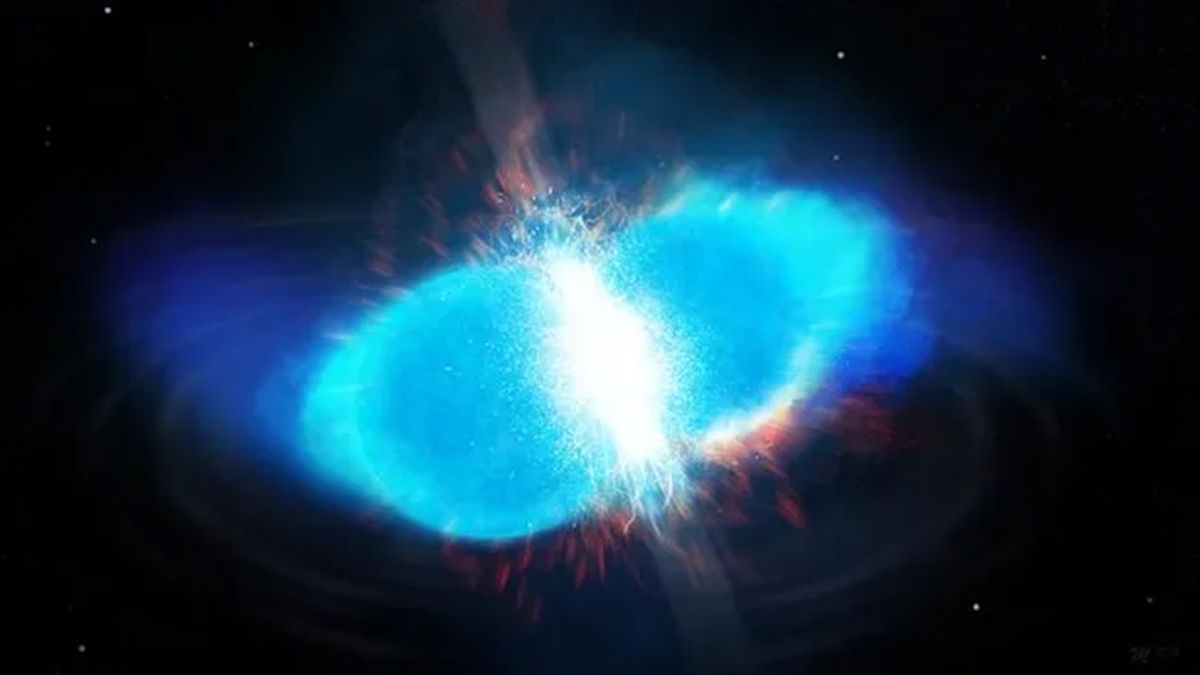1st evidence of nuclear fission in stars hints at elements 'never produced on Earth'
An analysis of 42 ancient stars in the Milky Way reveals the first hints of nuclear fission in the cosmos, hinting at the existence of elements far heavier than anything found naturally on Earth.

The silver and gold in your jewelry may be the result of massive, ancient stars splitting apart elements heavier than anything formed naturally on Earth, a new study suggests. The research offers the first compelling evidence of nuclear fission in the cores of massive stars.
Elements heavier than iron are thought to be born in some of the most violent explosions in the cosmos, like the cataclysmic mergers of neutron stars. The coalescence of these ultradense remnants — which are forged when once-massive stars collapse — creates superheavy atomic nuclei packed with neutrons in less than a second. In a flash, the jam-packed nucleus seems to go through internal changes and forms elements such as silver and gold.
Now, an analysis of the chemical makeup of 42 very old stars scattered in the halo of the Milky Way reveals for the first time that nuclear fission — a process through which an atom splits apart, releasing massive amounts of energy — plays a role in creating these heavy elements. A team of researchers discovered a consistent pattern among elements in these stars and found them to be the likely products of fission.
"This process is creating everything on the periodic table in one second," study co-author Matthew Mumpower, a theoretical physicist at the Los Alamos National Laboratory in New Mexico, told Live Science. "That’s pretty incredible."
The finding suggests that nature may forge elements with atomic masses greater than 260 — heavier than even those at the edge of the periodic table — before breaking them down again. While simulations of stellar evolution have suggested that this heavy-duty fission is likely to happen, the new research marks the first “direct evidence” of the process, lead study author Ian Roederer, a physicist and astronomer at North Carolina State University told Live Science.
Related: Nearby asteroid may contain elements 'beyond the periodic table', new study suggests
Patterns in the stars
The findings, published Dec. 7 in the journal Science, note a positive correlation among elements found in these ancient stars, most of which are as massive as the sun and are thought to have formed in the first 5 billion years after the Big Bang, or more than 9 billion years ago. The analysis showed there was a higher abundance of lighter elements, such as rhodium, silver and palladium (atomic masses 45 to 47 on the periodic table) in the stars, as well as an increased presence of heavier elements, like europium, erbium and others with atomic masses in the 60s.
Sign up for the Live Science daily newsletter now
Get the world’s most fascinating discoveries delivered straight to your inbox.
The 42 Milky Way stars exhibiting this pattern "have no communication with each other whatsoever," said Mumpower. "The only way they could follow the exact same trend is if there's a common process occurring in each of these different stars."
Without fission — which breaks the nucleus of an atom into two pieces, one heavier than the other — these elements must be produced separately. If this were the case, it would have led to a significantly different elemental ratio across various stars and not the consistent correlation the team detected, according to study co-author Nicole Vassh, a research scientist at the Tri-University Meson Facility in Canada.
So fission "can easily explain why the relative amounts of these elements would be consistent, since they would always be co-produced in the same manner," Vassh told Live Science in an email.
"It's important to recognize that the fissioning species predicted to be present here have never been produced on Earth," she added.
Other astronomers have agreed with the team's interpretation of this elemental data.
"The correlation stands out strongly," Darach Jafar Watson, an astrophysicist at the University of Copenhagen in Denmark who was not involved in the new research, told Chemical and Engineering News. "I cannot think of an alternate explanation, and while it is not conclusive, it seems a likely and reasonable interpretation."

Sharmila Kuthunur is a Seattle-based science journalist focusing on astronomy and space exploration. Her work has also appeared in Scientific American, Astronomy and Space.com, among other publications. She has earned a master's degree in journalism from Northeastern University in Boston. Follow her on BlueSky @skuthunur.bsky.social
Most Popular



